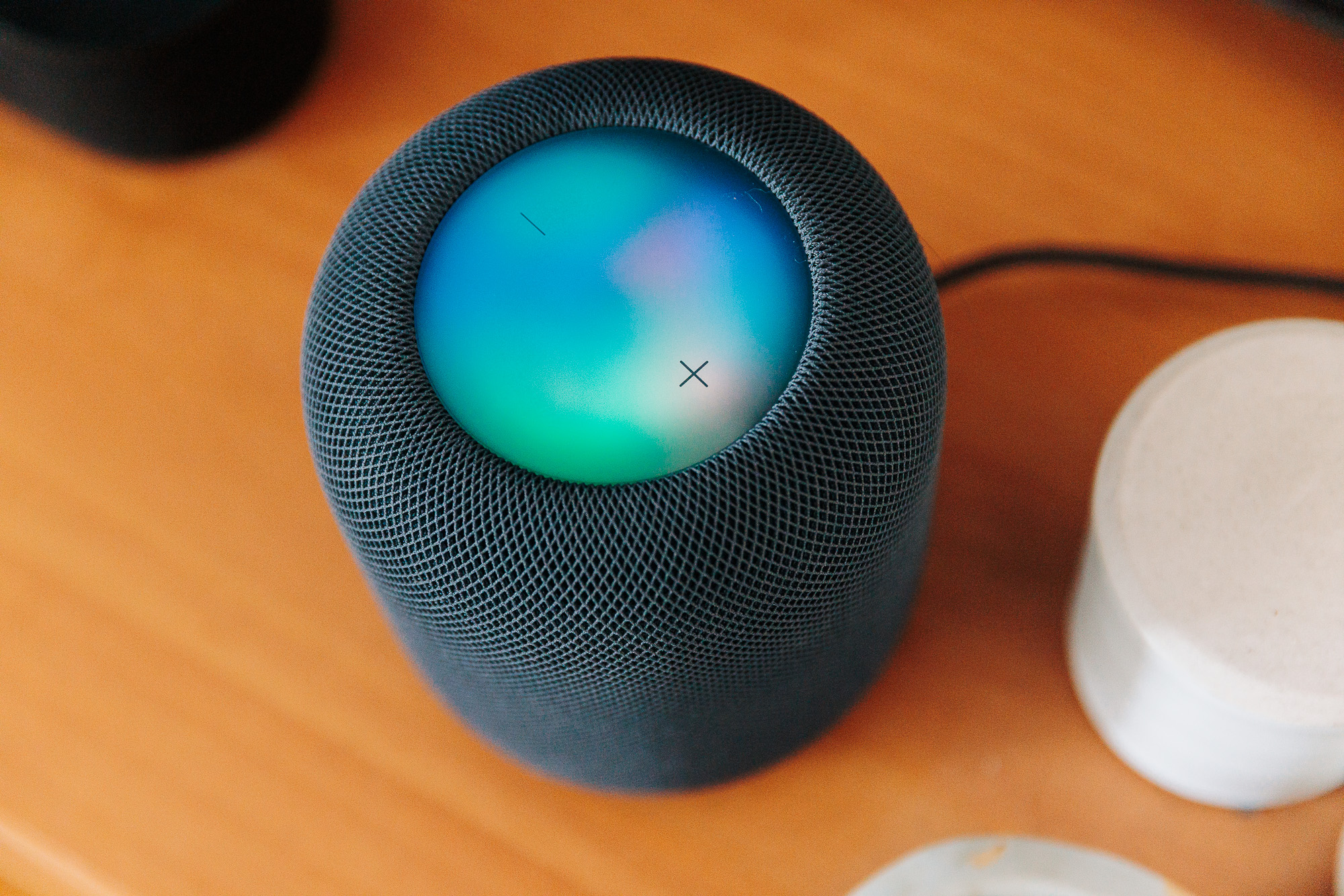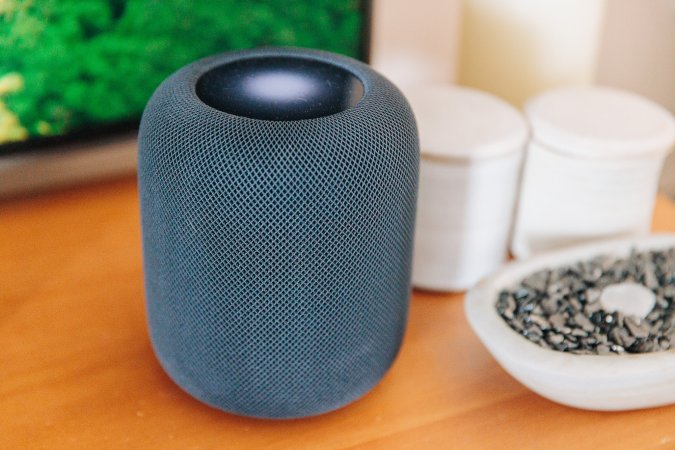

We may earn revenue from the products available on this page and participate in affiliate programs. Learn more ›
Apple introduced the original HomePod back in 2017 when the smart speaker arms race was still going on. Amazon’s Alexa and Google Assistant were vying for the right to take up residence in your home, while the ill-fated Microsoft Cortana and Samsung Bixby smart assistants toiled on the fringes. By most metrics, the HomePod was late to the party, and it attempted to overcome its tardiness with excellent sound quality and a sophisticated design you’d expect from the Cupertino crew. But it was quirky and lacked some features you’d expect from a high-end smart speaker, especially at the $350 price tag. Now, for the 2023 model, Apple has dropped the price $50, rearranged the internal speakers, improved its smart home chops, and added a few clever functions that make it worth considering, especially if you’re already fully immersed in the Apple ecosystem.
Here are some first impressions to hold you over until we’ve put together our extensive audio review in the coming weeks.
Setting up the HomePod (Gen. 2)
HomePod at home
I’m fully spoiled by Apple’s setup process for pretty much every device. I removed the HomePod from its meticulously designed packaging, plugged in the detachable power cord (a big upgrade over the integrated cord in the first version), and touched my iPhone to the speaker’s top.
I needed to apply the latest iOS update to my phone, but, disregarding the time that took, it was roughly five minutes from peeling back the tabs on the box to blasting Action Bronson in my living room in the middle of the night. While the entirety of the process is quick, the actual setup takes about two minutes, during which the HomePod plays a funky little chime over and over again to let you know it’s working. It’s almost long enough to wonder if it’s frozen, but it eventually just worked.
For smart homes, Matter matters
One very notable addition to the new HomePod is its compatibility with the new Matter smart home platform. We’re just starting to get Matter-certified devices that promise quick and easy setup regardless of the smart assistant ecosystem you’ve chosen. I primarily use Google Assistant for my smart home, but I set up the HomePod along with an Apple-provided, Matter-compatible smart plug.
The HomePod has come a long way from its quirky roots when it comes to controlling smart homes. It sets up easily and adds devices quickly and reliably. The only real issue I ran into with smart home functionality stemmed from the fact that my Apple TV and the Sonos Beam II soundbar attached to it both have the name “Living Room,” which confused things from time to time. At one point, I was playing Chick Corea’s “Spain” through my Apple TV, and it was playing from both the HomePod and the Sonos with a slight delay. It was an easy fix, but it could have been entirely avoided with more careful naming. Don’t make the same mistake I did.
Inside the new HomePod, Apple has now included a temperature and humidity sensor, which can funnel information to a connected thermostat. So, if you have hot or cold spots in your home, the HomePod can help condition the climate for whatever area you’re occupying.
Talking to the new HomePod is simple, and the device responds promptly, even when there’s music playing or the TV is on. The second-gen. model actually offers fewer microphones than the first-gen, but its voice recognition is at least as good and sometimes better than before. Siri also now recognizes specific voices when talking to the HomePod so that family members can get personalized functionality specific to their apps and activities.
First impressions: Sound performance
As I said before, we’re working on a more in-depth dive into the sound performance, but I can tell you that it sounds excellent in most situations. The first time you play music, the HomePod relies on its array of microphones to listen as sound bounces around the room, then adjusts playback for maximum performance. For instance, putting it too close to a wall could cause an unwanted bass boom, but the HomePod is smart enough to avoid it after a brief listen to its own performance.
The HomePod isn’t always listening and adjusting, however. The speaker’s built-in accelerometer waits to sense when the HomePod has moved, which triggers another listen in case the acoustic properties differ from its previous location.
I really like the HomePod’s overall sound. It pumps out ample bass most of the time. “Rollout (My Business),” Ludacris’s pre-Fast and Furious classic, rattled my floor sufficiently that it would have garnered a complaint from my downstairs neighbors if I had any. While there’s no way to fine-tune the HomePod sound on your own, there is, however, a low-bass mode. It reduces the boom in an effort to keep your fellow tenants happy.
Put on a track like “Delia’s Gone” by Johnny Cash, and you’ll really get to see the HomePod shine. It doesn’t undercut the boom in the man in black’s deep voice, but it lets the subtle squeak of the guitar strings sneak through before the depressing lyrics make you turn it off and listen to DJ Khaled to cheer up.
I did run into one tiny issue, however, and it has to do with my curious (or neurotic, if you want to be brutally honest about it) dog. The rattle from the bass made her curious about the speaker when I had it sitting on the floor. When she sniffed the speaker, she activated the top-mounted touch controls and paused the song. This happened four different times. Eventually, I put it on top of the TV stand.
So, who should buy the HomePod?
If you’re already a hardcore Apple user, this is the smart home speaker you want. It sounds great, sets up in a breeze, and looks just as slick as you’d expect. If you’re not already bought into Apple’s devices, it’s a harder sell. The addition of Matter compatibility certainly helps when it comes to compatibility, but the $300 price tag puts it in distinctly luxurious territory compared to its competition.
It’s also worth noting that you can buy these in pairs to enable multiroom audio, true stereo playback, and even Dolby Atmos surround sound when combined with an Apple TV 4K. While any HomePod (including the first-gen. and the Mini) will work with the multi-room audio function, you can’t make a stereo pair out of two different models.
Overall, I like the new HomePod a lot. It solves many of the quirks that came with the first model, and it performs as promised. Now, I just need to keep my dog’s nose away from the touch controls.

